Inkjet-Printed Dielectric Layer for the Enhancement of Electrowetting Display Devices
Abstract
:1. Introduction
2. Theory of Electrowetting and Inkjet Printing
2.1. Fundamentals of Electrowetting on Dielectric Layer
2.2. Principle of Inkject Printable Materials
3. Device Fabrication
3.1. Materials
3.2. Inkjet Printing for Dielectric Layer Fabrication
3.3. Film Characterization
3.4. EWD Device Fabrication
4. Results and Discussion
4.1. Inkjet Printing Photoresist Material
4.2. Performance of EWDs
5. Conclusions
Author Contributions
Funding
Data Availability Statement
Conflicts of Interest
References
- Lippmann, G. Relations entre les phénomènes électriques et capillaires. Ann. Chim. Phys. 1875, 5, 494–549. [Google Scholar]
- Frumkin, A. On the phenomena of wetting and adhesion of the bubbles. J. Phys. Chem. USSR 1938, 12, 337–345. [Google Scholar]
- Hayes, R.A.; Feenstra, B.J. Video-speed electronic paper based on electrowetting. Nature 2003, 425, 383–385. [Google Scholar] [CrossRef] [PubMed]
- Heikenfeld, J.; Zhou, K.; Kreit, E.; Raj, B.; Yang, S.; Sun, B.; Milarcik, A.; Clapp, L.; Schwartz, R. Electrofluidic displays using Young–Laplace transposition of brilliant pigment dispersions. Nat. Photonics 2009, 3, 292–296. [Google Scholar] [CrossRef]
- Blankenbach, K.; Schmoll, A.; Bitman, A.; Bartels, F.; Jerosch, D. Novel highly reflective and bistable electrowetting displays. J. Soc. Inf. Disp. 2012, 16, 237–244. [Google Scholar] [CrossRef]
- Kuiper, S.; Hendriks, B.H.W. Variable-focus liquid lens for miniature cameras. Appl. Phys. Lett. 2004, 85, 1128–1130. [Google Scholar] [CrossRef]
- Berge, B.; Peseux, J. Variable focal lens controlled by an external voltage. An application of electrowetting. Eur. Phys. J. E 2000, 3, 159–163. [Google Scholar] [CrossRef]
- Hendriks, B.H.W.; Kuiper, S.; VAN As, M.A.J.; Renders, C.A.; Tukker, T.W. Electrowetting-Based Variable-Focus Lens for Miniature Systems. Opt. Rev. 2005, 12, 255–259. [Google Scholar] [CrossRef]
- Abdelgawad, M.; Watson, M.W.; Wheeler, A.R. Hybrid microfluidics: A digital-to-channel interface for in-line sample processing and chemical separations. Lab Chip 2009, 9, 1046–1051. [Google Scholar] [CrossRef]
- Cho, S.K.; Moon, H.; Kim, C.J. Creating, transporting, cutting, and merging liquid droplets by electrowetting-based actuation for digital microfluidic circuits. J. Microelectromech. Syst. 2003, 12, 70–80. [Google Scholar] [CrossRef]
- Moon, H.; Wheeler, A.R.; Garrell, R.L.; Loo, J.A.; Kim, C.-J. An integrated digital microfluidic chip for multiplexed proteomic sample preparation and analysis by MALDI-MS. Lab Chip 2006, 6, 1213–1219. [Google Scholar] [CrossRef] [PubMed]
- Barbulovic-Nad, I.; Yang, H.; Park, P.S.; Wheeler, A.R. Digital microfluidics for cell-based assays. Lab Chip 2008, 8, 519–526. [Google Scholar] [CrossRef] [PubMed]
- Hagedon, M.; Yang, S.; Russell, A.; Heikenfeld, J. Bright e-Paper by transport of ink through a white electrofluidic imaging film. Nat. Commun. 2012, 3, 1173. [Google Scholar] [CrossRef]
- Sun, B.; Zhou, K.; Lao, Y.; Heikenfeld, J.; Cheng, W. Scalable fabrication of electrowetting displays with self-assembled oil dosing. Appl. Phys. Lett. 2007, 91, 383. [Google Scholar] [CrossRef]
- Liu, H.; Dharmatilleke, S.; Maurya, D.; Tay, A. Dielectric materials for electrowetting-on-dielectric actuation. Microsyst. Technol. 2010, 16, 449–460. [Google Scholar] [CrossRef]
- Li, Z.; Haigh, A.; Soutis, C.; Gibson, A.; Sloan, R. Dielectric constant of a three-dimensional woven glass fibre composite: Analysis and measurement. Compos. Struct. 2017, 180, 853–861. [Google Scholar] [CrossRef]
- Bormashenko, E.; Pogreb, R.; Bormashenko, Y.; Aharoni, H.; Shulzinger, E.; Grinev, R.; Rozenman, D.; Rozenman, Z. Progress in low voltage reversible electrowetting with lubricated polymer honeycomb substrates. RSC Adv. 2015, 5, 32491–32496. [Google Scholar] [CrossRef]
- Detcheverry, F.A.; Pike, D.Q.; Nealey, P.F.; Müller, M.; de Pablo, J.J. Simulations of theoretically informed coarse grain models of polymeric systems. Faraday Discuss. 2010, 144, 111–125. [Google Scholar] [CrossRef]
- Shen, H.; Chung, L.; Yao, D. Improving the dielectric properties of an electrowetting-on-dielectric microfluidic device with a low pressure chemical vapor deposited Si3N4 dielectric layer. Biomicrofluidics 2015, 9, 022403. [Google Scholar] [CrossRef]
- Mats, L.; Bramwell, A.; Dupont, J.; Liu, G.; Oleschuk, R. Electrowetting on superhydrophobic natural (Colocasia) and synthetic surfaces based upon fluorinated silica nanoparticles. Microelectron. Eng. 2015, 148, 91–97. [Google Scholar] [CrossRef]
- Ghazzal, M.N.; Joseph, M.; Kebaili, H.; De Coninck, J.; Gaigneaux, E.M. Tuning the selectivity and sensitivity of mesoporous dielectric multilayers by modifiying the hydrophobic–hydrophilic balance of the silica layer. J. Mater. Chem. 2012, 22, 22526–22532. [Google Scholar] [CrossRef]
- Kudr, J.; Richtera, L.; Nejdl, L.; Xhaxhiu, K.; Vitek, P.; Rutkay-Nedecky, B.; Hynek, D.; Kopel, P.; Adam, V.; Kizek, R. Improved electrochemical detection of zinc ions using electrode modified with electrochemically reduced graphene oxide. Materials 2016, 9, 31. [Google Scholar] [CrossRef] [PubMed]
- Wu, J.; Xia, J.; Lei, W.; Wang, B.P. Electrowetting on ZnO nanowires. Appl. Phys. A 2010, 99, 931–934. [Google Scholar] [CrossRef]
- Papadopoulou, E.L.; Pagkozidis, A.; Barberoglou, M.; Fotakis, C.; Stratakis, E. Electrowetting Properties of ZnO and TiO2 Nanostructured Thin Films. J. Phys. Chem. C 2010, 114, 10249–10253. [Google Scholar] [CrossRef]
- Bienia, M.; Quilliet, C.; Vallade, M. Modification of Drop Shape Controlled by Electrowetting. Langmuir 2003, 19, 9328–9333. [Google Scholar] [CrossRef]
- Welters, W.; Fokkink, L. Fast Electrically Switchable Capillary Effects. Langmuir 1998, 14, 1535–1538. [Google Scholar] [CrossRef]
- Del Bene, J.E.; Alkorta, I.; Elguero, J. Using one halogen bond to change the nature of a second bond in ternary complexes with PCl and F Cl halogen bonds. Faraday Discuss. 2017, 203, 29–45. [Google Scholar] [CrossRef]
- Burger, B.; Rabot, R. Design of low hysteresis electrowetting systems in non-aqueous media by the addition of low HLB amphiphilic compounds. Colloids Surf. A Physicochem. Eng. Asp. 2016, 510, 129–134. [Google Scholar] [CrossRef]
- Tamaddoni, N.; Taylor, G.; Hepburn, T.; Kilbey, S.M.; Sarles, S.A. Reversible, voltage-activated formation of biomimetic membranes between triblock copolymer-coated aqueous droplets in good solvents. Soft Matter 2016, 12, 5096–5109. [Google Scholar] [CrossRef]
- Kopp, D.; Zappe, H. Tubular astigmatism-tunable fluidic lens. Opt. Lett. 2016, 41, 2735–2738. [Google Scholar] [CrossRef]
- Xiao, K.; Zhou, Y.; Kong, X.Y.; Xie, G.; Li, P.; Zhang, Z.; Wen, L.; Jiang, L. Electrostatic-Charge and Electric-Field Induced Smart Gating for Water Transportation. ACS Nano 2016, 10, 9703–9709. [Google Scholar] [CrossRef] [PubMed]
- Vijay, K.; Sharma, N.N. SU-8 as Hydrophobic and Dielectric Thin Film in Electrowetting-on-Dielectric Based Microfluidics Device. J. Nanotechnol. 2012, 2012, 312784.1–312784.6. [Google Scholar] [CrossRef]
- Mugele, F.G.; Baret, J.C. Electrowetting: From basics to applications. Inst. Phys. 2005, 17, R705. [Google Scholar] [CrossRef]
- Cummins, G.; Desmulliez, M.P.Y. Inkjet printing of conductive materials: A review. Circuit World 2012, 38, 193–213. [Google Scholar] [CrossRef]
- He, B.; Yang, S.; Qin, Z.; Wen, B.; Zhang, C. The roles of wettability and surface tension in droplet formation during inkjet printing. Sci. Rep. 2017, 7, 11841. [Google Scholar] [CrossRef] [PubMed]
- Yang, X.; Lin, Y.; Wu, T.; Yan, Z.; Chen, Z.; Kuo, H.C.; Zhang, R. An overview on the principle of inkjet printing technique and its application in micro-display for augmented/virtual realities. Opto-Electron. Adv. 2022, 5, 210123-1–210123-24. [Google Scholar] [CrossRef]
- Castrejon-Pita, A.A.; Betton, E.S.; Campbell, N.; Jackson, N.; Morgan, J.; Tuladhar, T.R.; Vadillo, D.C.; Castrejon-Pita, J.R. Formulation, Quality, Cleaning and other Advances in InkJet Printing. At. Sprays 2021, 31, 57–79. [Google Scholar] [CrossRef]
- Fromm, J.E. Numerical calculation of the fluid dynamics of drop-on-demand jets. IBM J. Res. Dev. 1984, 28, 322–333. [Google Scholar] [CrossRef]
- Reis, N.; Derby, B. Ink Jet Deposition of Ceramic Suspensions: Modeling and Experiments of Droplet Formation. MRS Online Proc. Libr. Arch. 2000, 625, 117. [Google Scholar] [CrossRef]
- Stringer, J.; Derby, B. Formation and stability of lines produced by inkjet printing. Langmuir 2010, 26, 10365–10372. [Google Scholar] [CrossRef]
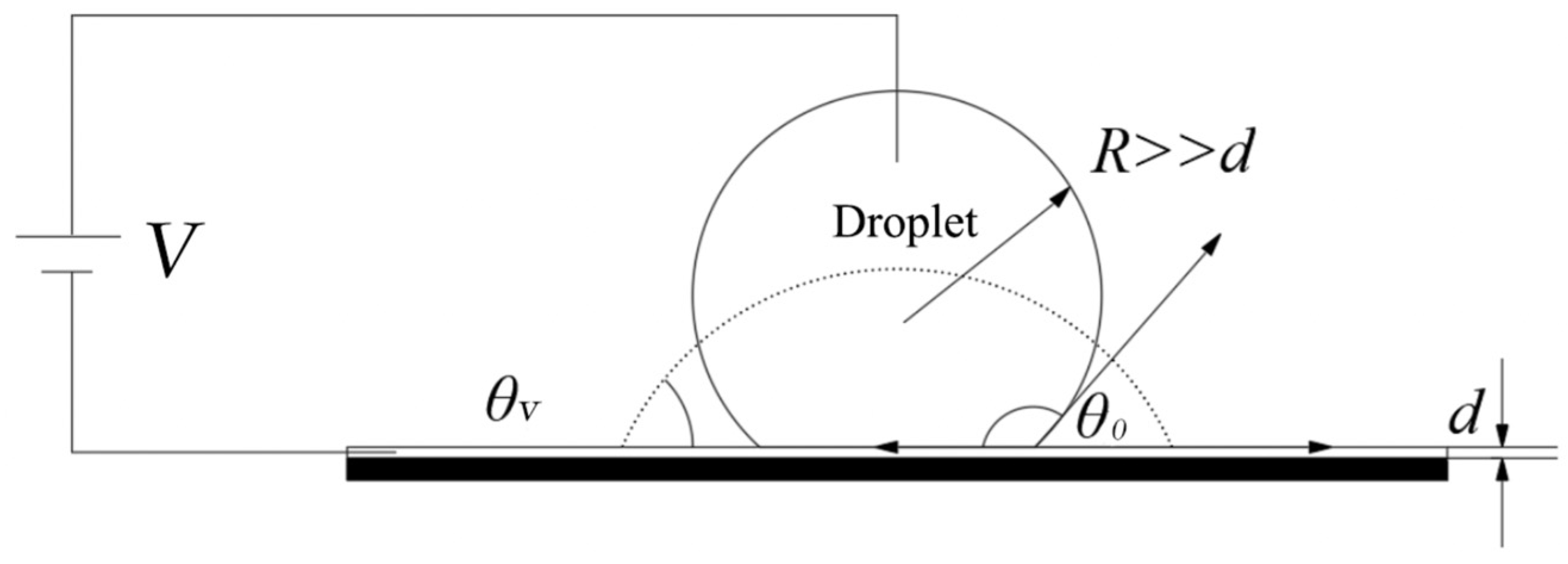

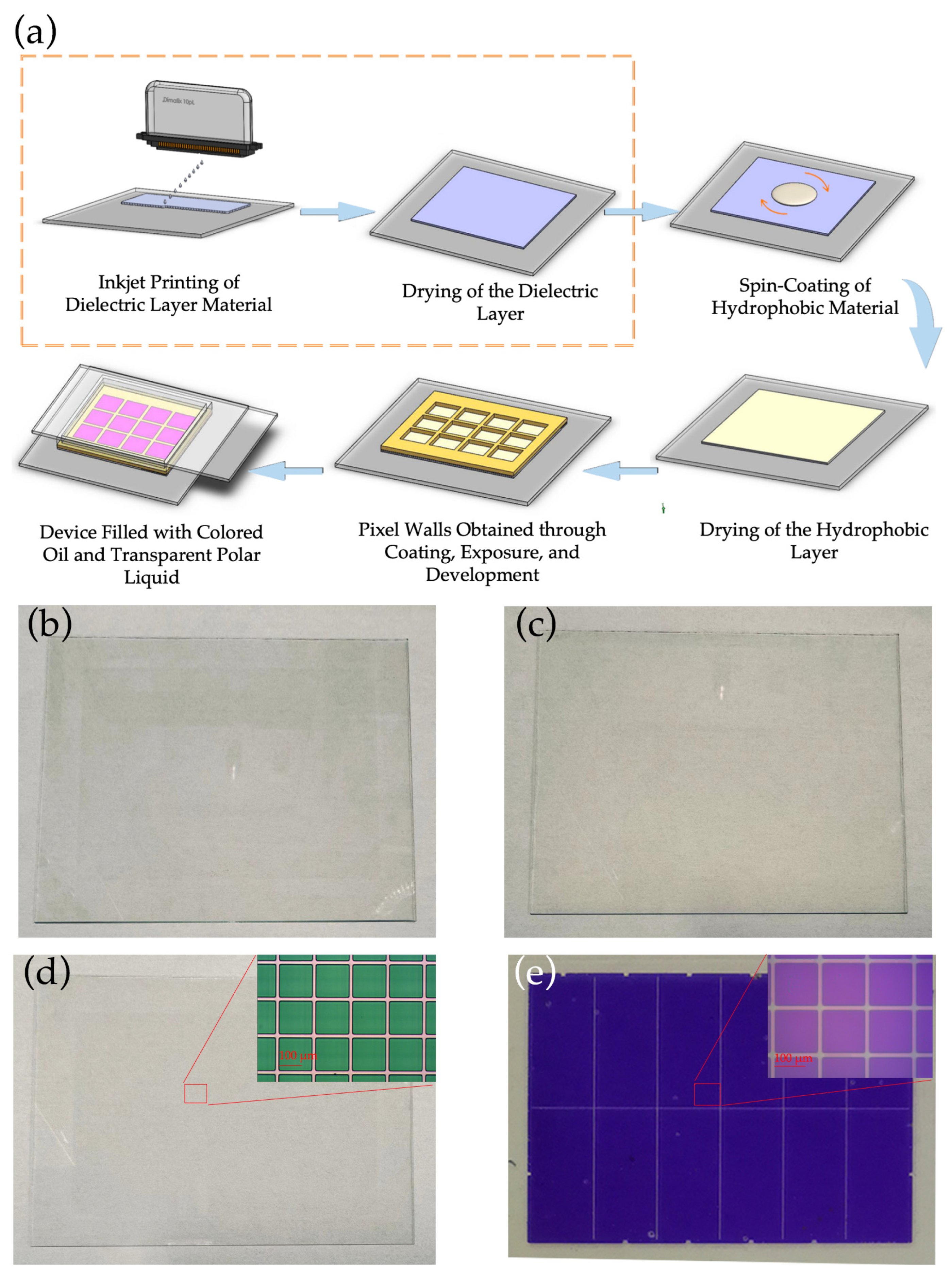
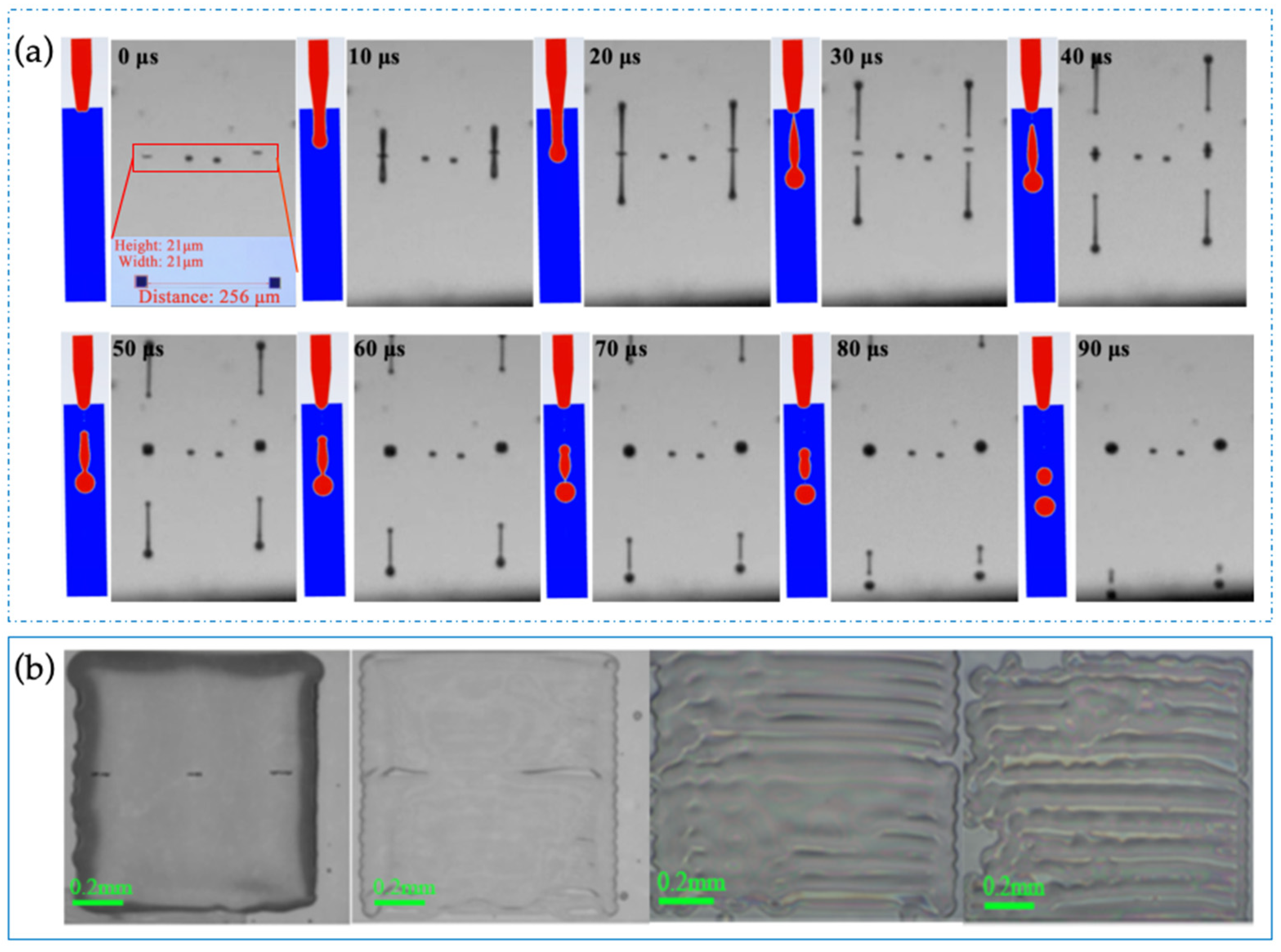
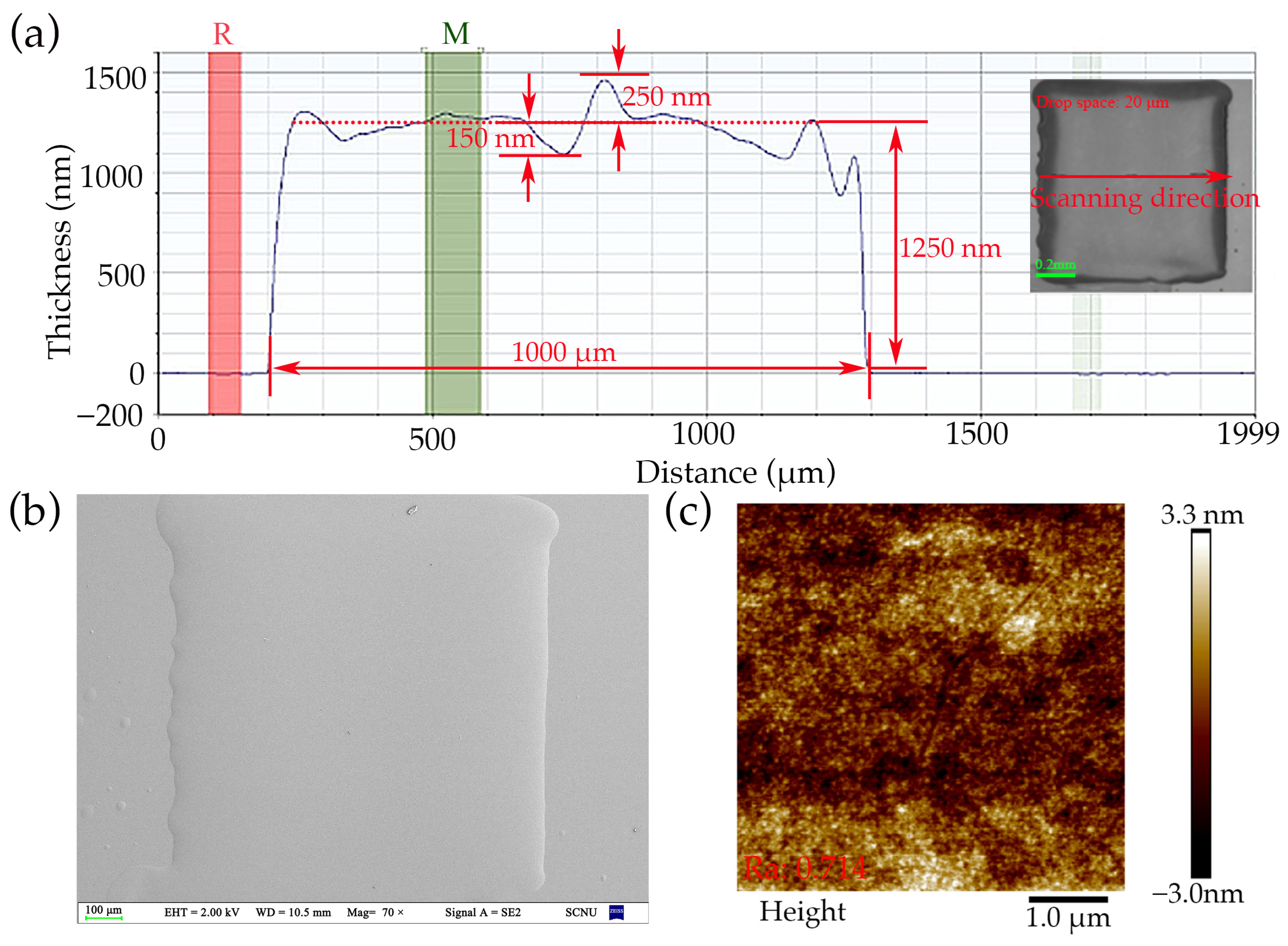
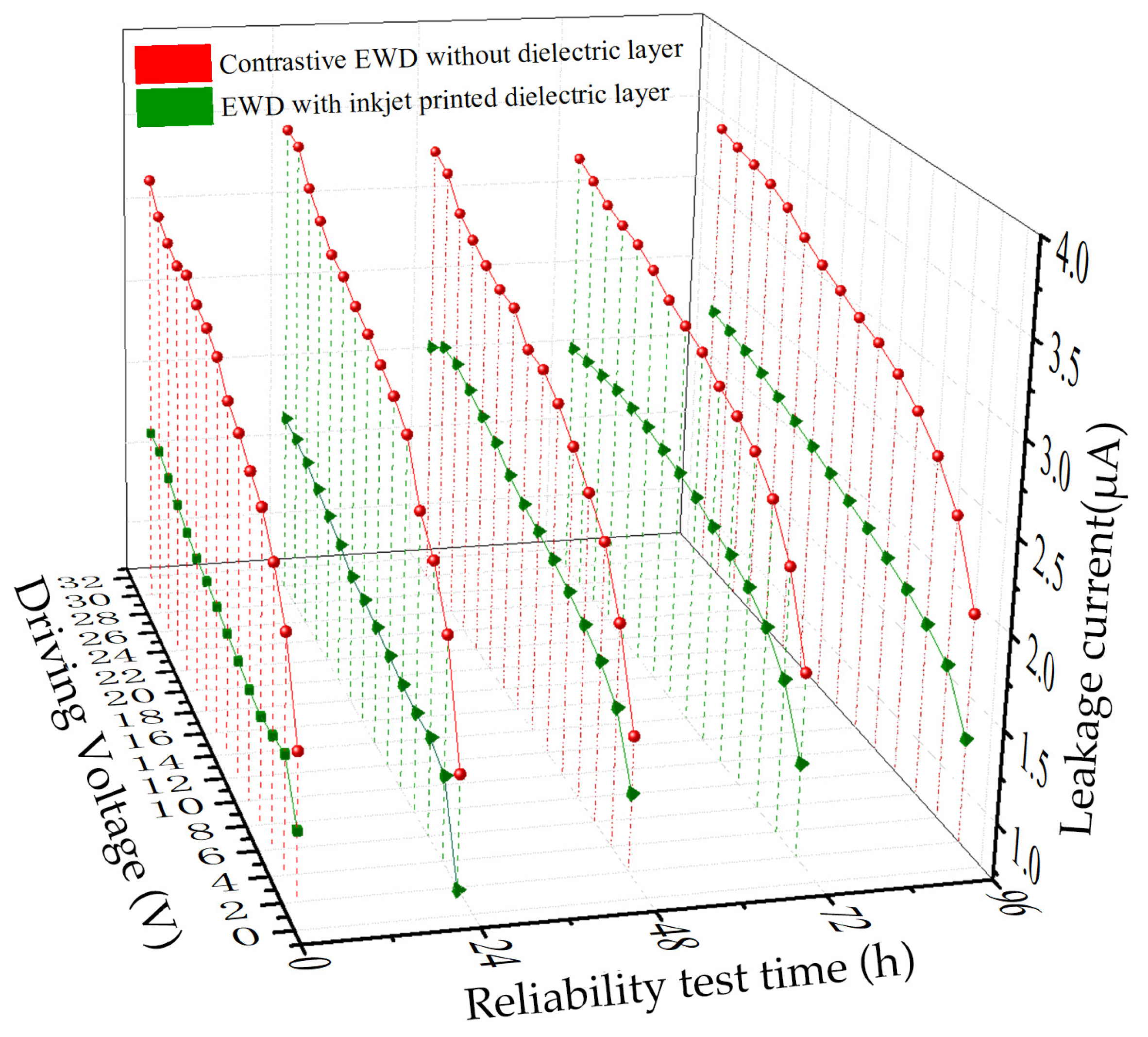

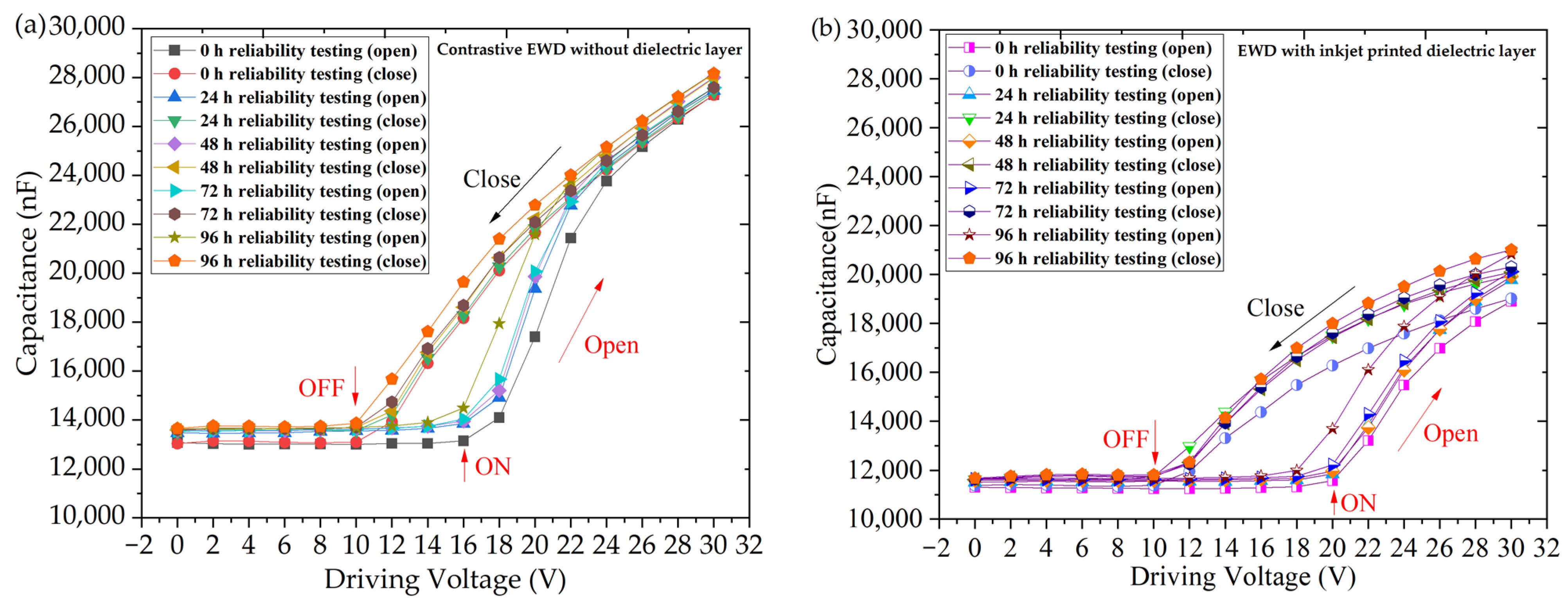

| Material Parameters | Value | Print Parameters | Value |
|---|---|---|---|
| Material | HN-1091 | Nozzle dia. (μm) | 21 |
| Solvent | PGMEA | temperature (°C) | 45 |
| Concentration | 19% | Frequency (kHz) | 1.5 |
| Density (kg/m3) | 1010 | Voltage (V) | 35 |
| Viscosity (mPa·s) | 3.783 | velocity (m/s) | 8 |
| Surface tension (mN/m) | 11.34 | Z (Oh−1) | 4.1 |
Disclaimer/Publisher’s Note: The statements, opinions and data contained in all publications are solely those of the individual author(s) and contributor(s) and not of MDPI and/or the editor(s). MDPI and/or the editor(s) disclaim responsibility for any injury to people or property resulting from any ideas, methods, instructions or products referred to in the content. |
© 2024 by the authors. Licensee MDPI, Basel, Switzerland. This article is an open access article distributed under the terms and conditions of the Creative Commons Attribution (CC BY) license (https://creativecommons.org/licenses/by/4.0/).
Share and Cite
Jiang, H.; Qian, R.; Yang, T.; Guo, Y.; Yuan, D.; Tang, B.; Zhou, R.; Li, H.; Zhou, G. Inkjet-Printed Dielectric Layer for the Enhancement of Electrowetting Display Devices. Nanomaterials 2024, 14, 347. https://doi.org/10.3390/nano14040347
Jiang H, Qian R, Yang T, Guo Y, Yuan D, Tang B, Zhou R, Li H, Zhou G. Inkjet-Printed Dielectric Layer for the Enhancement of Electrowetting Display Devices. Nanomaterials. 2024; 14(4):347. https://doi.org/10.3390/nano14040347
Chicago/Turabian StyleJiang, Hongwei, Rongzhen Qian, Tinghong Yang, Yuanyuan Guo, Dong Yuan, Biao Tang, Rui Zhou, Hui Li, and Guofu Zhou. 2024. "Inkjet-Printed Dielectric Layer for the Enhancement of Electrowetting Display Devices" Nanomaterials 14, no. 4: 347. https://doi.org/10.3390/nano14040347






